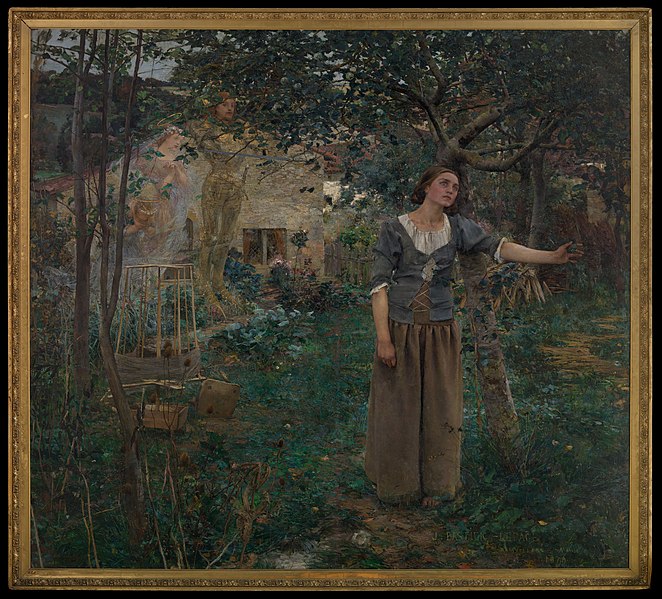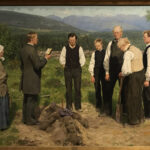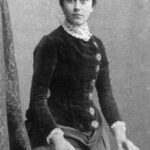My grief would overwhelm me if I were not in God's grace. — Joan of Arc, February 24, 1431
Joan of Arc is in mourning the day her king is crowned. The slender seventeen-year-old stands in full armor. As commander of France’s army, she bears her white standard of a field sprinkled with lilies, an angel on each side, inscribed with the words JHESUS MARIA. The banner has been with her through the blood-soaked battles that led to this day. “It shared in the pain,” she says. “It’s only right that it share in the honors.”
The coronation of King Charles VII of France takes place in Reims Cathedral on Sunday, July 17, 1429. For years both France and England have asserted a blood right to the throne. Burgundians may have allied with the English, but today, the dauphin asserts his claim and accepts his crown from Archbishop Regnault de Chartres. Charles could not have done it without a teenage girl from Domrémy village.
Joan, known as the Maid, stands in a place of honor, surrounded by her parents, Jacques and Isabelle; along with her older brothers, Jean and Pierre. The eldest son, Jacquemin, cannot attend. And someone else is missing.
Joan’s only sister died two months ago, in May, 1429.
Catherine was a few years older than Joan. They frequented Domrémy and neighboring Greux, attended services together, and learned sewing, spinning, and shepherding from their parents. Their family lived, Joan says, “in a two-story house, with two lofts above the rooms, two small corridors in front of the house, with a small chicken coop.” There is little doubt the girls shared a room and a bed as was customary in village homes.
Life in Domrémy had improved in general due to the ravages of the Black Death a century earlier, when a decreased population presented opportunities for survivors. The village was surrounded by rivers and streams which helped the growth of wheat, rye, and oats. Neighboring hills were forested with beech and oak: ideal for building, heating, and supplying acorns for pigs, the main economic strength of Domrémy, along with cattle, horses, sheep, and fowl. Wine from the vineyards of nearby Greux was as much a staple as cheese, milk, pork, beef, and poultry.
Joan’s father, Jacques, owned some fifty acres, thirty of which were pasture and farmland; the other twenty, woodland. Joan was often tasked with tending the fields, using hoe and plough, as well as guarding their livestock, she said, “until I reached the age of reason.” As a comfortably affluent landowner, Jacques was a dean of Domrémy and responsible for the village’s defense, taxes, and accuracy in weights and measures. He accompanied the mayors of Domrémy and Greux with seven other notables to pay tribute to the lord of Commercy in 1423. It is not surprising, then, that his first daughter, Catherine, was soon wed to Colin, the son of Greux’s mayor.
But nothing prepared Jacques for the astonishing news that his other daughter, Joan, had led the French army in taking the city of Rheims from the English. French kings had always been crowned there, but Charles was unwilling to enter enemy territory. Hearing this, Joan undertook a series of battles against nearby towns to ensure the dauphin’s safe passage.
Now as she rides with Charles through northern France, townspeople throw open their gates to allow the royal procession to pass. Joan herself leads the dauphin into Rheims.
The next day, as light streams through the stain-glassed windows of the vast Rheims Cathedral, Joan stands beside Charles as he is crowned king. Her family has traveled from Domrémy for the occasion. Jacques and his wife are in awe. Then they receive a shock.
The new king instructs Joan to name a royal favor for all that she has done. She asks nothing for herself but instead requests that the people of her village of Domrémy and Greux be freed from the burden of taxation. Two weeks later, Charles VII signs a decree to that effect, writing three words in explanation: “Nothing: the Maid.”
Joan’s request on behalf of her townsfolk is not as odd as it may seem. She was selfless by nature and her concern for others is a common aspect of grief. Many people suffering from stress and acute sorrow turn outward as a means of daily survival. Robert Neimeyer, a leading authority on grief, observes that in their search for meaning, the bereaved often commiserate with fellow mourners, displaying compassion and searching for a sense of transcendence.
The regal coronation is a vindication of Joan’s actions to free France and a moment of parental pride. But for the entire family, it is also a day of joy tinged with sorrow; or more accurately, sorrow tinged with joy. Joan’s parents know that she has more battles ahead. They leave for Domrémy as they mourn one daughter and fear for the future of another. This is the last time her parents will see Joan until the day of her death.
Visions and Voices
France is in religious and political turmoil. Believers’ faith has been badly shaken by the Papal Schism of 1378, which lasted forty years. Two men, then three, each insisted that he alone was the true pope. The question is resolved in 1417, but the ongoing Hundred Years War, which started in 1337 and will not end until 1453, has left much of France occupied by English forces.
Joan’s home in Domrémy is on the Gallic side of the Vaucouleurs castellany in northeastern France. There are frequent unofficial skirmishes between village boys from across the English boundary. Orléans has been under siege by the English since October of 1428. The people of Vaucouleurs, Mont-Saint-Michel, and Tournai are the last remaining bastion of support north of the Loire for the Dauphin Charles.
But the dauphin, once brave and reckless in his youth, now seems unwilling to act. For his people, papal supremacy and royal status are not political debates: they are questions of faith, just rule, and divine right. This series of disasters creates a vacuum.
People yearn for a sign, a prophet, a mystic.
One summer afternoon in 1424, Joan, a village girl of Domrémy, senses herself “surrounded on all sides by a great light,” she says. The thirteen-year-old cannot speak or move out of sheer terror. This, her first vision, is in keeping with well-known angelic visitations, including biblical accounts, in which heavenly messengers often announce: “Fear not!”
More spiritual manifestations follow.
Over time Joan experiences Michael the Archangel, Catherine of Alexandria, Margaret of Antioch, Gabriel, and a large number of angels. “Were I in a wood, the voices would still come to me,” she insists. “A day does not pass when I do not hear it; I need them so.” Her visitors speak with her plainly and in clear, concise terms, each with a unique personality, she relates. When asked if the voice is that of an angel or a saint, Joan replies, “It is from God.”
Her response is not surprising. Mystics frequently have difficulty putting their experiences into words. Joan uses voice and voices interchangeably, sometimes in the same sentence. The best she can do, she explains, is to say that her visions are extremely real. “Joan’s ‘problem’, like that of religious visionaries throughout history,” observes biographer Donald Spoto, “was to report an ineffable experience, to find some sort of expression within the currency of her own religious and cultural norms.”
Joan is not the only member of her family to have visions.
Throughout Joan’s childhood, her father, Jacques, occasionally wakes his wife in the night to relate a recurring dream of their daughter “going off with men-at-arms.” He fears that she might become a camp follower—a euphemism for prostitutes that inevitably make themselves available near military encampments. “If what I fear will happen with Joan, does happen,” he tells Isabelle, “I’d rather you drowned her, and if you don’t, I’ll drown her myself.” Before we berate Jacques for an impious interpretation of his dreams, we need look no further than Ezekiel or John of Patmos to find evidence of other men who struggled to understand visions that were far outside their usual frame of reference.
Still, his explanation seems at odds with what we know about young Joan. Some 115 witnesses that knew her from infancy, including a number of priests, described her repeatedly as good, sweet-natured, devout, simple, pious, and pure. It was well known that she was a regular attendee at the local parish. But parental fears, alas, seldom jibe with reality.
His dreams lead Jacques to keep Joan close at home. He also attempts to marry her off quickly. But Joan rejects potential suitors, including one man in the city of Toul who is so incensed that he brings Joan before the court of justice to force her to be his bride. The court finds in Joan’s favor. “From the first time I heard the voice,” Joan explains, “I vowed to remain a virgin for as long as God so pleased.”
Jacques’s prescient visions of his daughter in the company of soldiers ultimately become reality—but not in the way he fears. While in Domrémy, Joan’s voices continuously urge her, “Go, daughter of God, go.” Where she goes and what she does are unique in the history of the world.
Mystic with a Mission
Joan approaches the Dauphin Charles in March of 1429 and boldly announces her divine mission to deliver Orléans and save France. The dauphin is dubious. He has an ecclesiastical commission question this audacious seventeen-year-old. Joan’s examiners tell him they are convinced that her visions are genuine. This is not without precedent. Since the time of the Black Death, a tradition has arisen of young peasants leaving their flocks to perform sacred tasks. Charles sees in Joan a leader to rally his people. She proves him right.
Joan is given command of some 7,000 men, including the most famous captains of the day, as the army’s chef de guerre (war chief). On March 22, 1429, she dictates a letter to the King of England, ordering his forces to surrender and withdraw. If they do not, she warns, “I will order them killed, to the last man, for I am sent by God, Lord of Heaven, to throw you out of France, body by body.”
Joan does not shirk from her responsibility, or the suffering she feels for the deaths that result from her orders. “Sent by God, she, normally a gentle, pious country girl,” writes Nadia Margolis with Mount Holyoke College, “would kill as often as necessary and without hesitation to achieve her goal.” Joan sees her mission as an incarnation of divine will.
Joan’s detractors in the twenty-first century often dismiss her visions and voices as the result of a mental pathology, such as bipolar disorder or schizophrenia. Others, like Larissa Juliet Taylor with Colby College, think that Joan lied to break free of societal constraints and to pursue her aims. “Was she doing so at the behest of God?” Taylor asks. “It is impossible to know.” These modern explanations seem reasonable on the surface, but they may be asking the wrong questions.
Gwendolyn Morgan with Montana State University notes that we have left the real Joan far behind in our rush to apply modern psychiatric terms. “All these recreations,” writes Morgan, “ignore the fundamental medieval reality of Joan as a woman of unshakable faith in her personal and profound experience of Christianity.” Respected medievalist Juliet Barker agrees, adding that what matters is Joan’s belief in her visions.
Attempting to diagnose Joan with a physical or psychological disorder serves no purpose, says Helen Castor, a Fellow of Sidney Sussex College. Societal and religious views in fifteenth-century France were vastly different from our modern world. Visions were considered commonplace. Men and women of sound mind frequently had spiritual encounters that were taken at face value. There was no question at the time as to whether Joan’s experiences were real. “The problem was how to tell whether her voices came to her from heaven or hell,” Castor concludes.
Such mystical experiences have striking parallels with many aspects of grief, such as the sorrow caused by Joan’s loss of her sister, writes David Aberbach with McGill University. Both display withdrawal, searching, keening, despair, communion, and the realization of a new identity. Mysticism and grief are not equal, but each may lead to transformation and a previously undiscovered spirituality. This was true with another mystic, Thérèse of Lisieux.
While reading about Joan’s life, Thérèse received what she considered the core revelation that led to her own vocation as a Carmelite. At that moment, writes the nineteenth-century nun, “I received a grace which I have always looked upon as one of the greatest of my life.” Though the two women were separated by four centuries, observes Randall Rosenberg with Fontbonne University, Thérèse is still thought of today as Joan’s spiritual younger sister.
Skeptical simplifications of Joan’s life are not entirely convincing. She did not seek power, wealth, or fame. “I ask for no final reward,” she tells critics in her own time, “other than the salvation of my soul.” A close examination of the historical record provides more evidence of the miraculous than the pathological.
The Siege of Orléans
Orléans is “the boulevard to invasion,” writes historian Régine Pernoud with the Museum of the History of France. The town’s bridge over the Loire is seen by the English as a key military location. They assign an experienced captain, Thomas Montague, to lay siege to Orléans on October 12, 1428. Montague’s blockade and war of attrition nearly works. The town fathers send a delegation to discuss terms with the Duke of Burgundy.
Then the unexpected happens.
Joan’s convoy of 500 men arrives outside Orléans on April 28, 1429. She enters the city the next day. Soon reinforcements appear. The following week sees the bloodiest fighting of the siege.
Twice Joan writes to the English, demanding that they leave. The last letter is delivered by her herald, Guienne, who is promptly taken prisoner. When, on May 5, hostilities cease to honor the Feast of the Ascension, Joan writes a third and final warning to her enemies. She sends for an archer and instructs him to fasten the missive to an arrow and fire it into the English camp: “Men of England, who have no right to be in France, the Lord of Heaven commands you through me, Joan the Maid, to abandon your garrison and return to your own land. Leave now or I will raise a war cry that will echo through eternity.”
Two days later, during a skirmish on May 7, an arrow pierces Joan’s armor, driving several inches between her neck and shoulder. That night Joan weeps to the point of exhaustion at the sight of the slain on both sides. The next day, on May 8, 1429, after 6 months 3 weeks and 5 days, the English forces leave Orléans. Joan has ended the siege in a little over a week.
“No miracle was ever so clear,” writes prominent fifteenth-century author Christine de Pizan of the events at Orléans. “A girl of sixteen (I ask you, is that natural?)” Pizan’s “Hymn to Joan of Arc” is the only tribute written during Joan’s lifetime. It is a lyrical verse of sixty-one stanzas that focuses on heroism, the dignity of women, peace, and the ultimate victory of good over evil. Pizan begins her poem just after the coronation in Reims, casting the story in a scriptural light. She compares Joan to giants of faith like Esther, Ruth, Gideon, Deborah, and others.
Sacred, profound, in her life we see God's grace; in all things she looks to Him, calls Him, serves Him, in words, in deeds; in all places, devout, relentless.
A Sister’s Sorrow
During or shortly after the fighting at Orléans, Joan’s sister, Catherine, dies in childbirth at the age of twenty-four. Before Catherine’s death, Joan has always been fearless, dreading only the dark shadow of betrayal. Experiences both spiritual and martial honed her survival instincts while increasing her dependence on the voices of God’s messengers. But this is a blow Joan cannot prevent; a battle that cannot be won through belligerence, cunning, or miracle.
Siblings feel a tremendous sense of failure at the death of a brother or sister, says Albert Cain with the University of Michigan. For those who lose a family member to an accident, 78 percent feel persistent guilt. If Joan was like so many sisters before and since, she may have felt responsible for the loss: she failed to keep Catherine safe; she should have been there. Respected grief researcher Ronald Knapp, Clemson University, suggests that this sense of shame and remorse seems to be inescapable. Joan may have felt that her own shortcomings somehow contributed to Catherine’s death.
Then as now, the death of a sibling has marked similarities to losing a child. Yet despite the striking parallels between these types of grief, mourning for a sister or brother receives scant social recognition. Psychotherapist Julia Samuel, an expert in sibling loss, observes that “although 80 percent of the population has a sibling, we as a society give it less acknowledgement than it deserves.” Debora Davidson with York University goes a step further, calling siblings the “forgotten mourners.”
Many siblings report pressure to cope well and appear normal. Yet they frequently experience existential chaos and trauma. “Internally the bereaved sibling struggles with intense emotions,” says clinical psychologist Eleferia Woodrow, adding that an unspoken conspiracy of silence surrounds sibling grief and increases their sense of isolation. The initial shock of losing a brother or sister may last for months; the grief endures for years. Little wonder, then, that when Joan’s cousin Jeanne has a daughter that same year, she asks that the girl be named Catherine Robert in honor of Joan’s sister.
Betrayal
A month after the coronation of Charles VII, in August, Joan’s hectic, heartbreaking, victorious spring and summer begin to take their toll. In five short months she has returned to France its rightful territories. Her mission is fulfilled. By now her brothers, Jean and Pierre, are part of the company, but still she yearns for Domrémy. “If only it would please God, my creator, that I might leave,” Joan says, “that I might set aside my armor and return in service to my parents, tending their flocks; how they would rejoice to have me home.”
This is not wistful nostalgia. Rather, it is a desperate plea of grief and exhaustion, suggests English poet Robert Southey. He frequently returns to the theme of Joan’s sorrow in his 1853 epic poem about the Maid. “Her mind’s eye beheld Domrémy and the fields of Arc,” he writes. “Her burden’d heart was full; such grief she felt.”
Yet Joan perseveres. She is a bold and gifted tactician, albeit a mediocre strategist. At times clever, at others cagey, she takes advantage of opportunities as they arise. But the complexities of international and court relations are beyond her.
King Charles VII is hoping to bargain a peace with Burgundy; negotiations with the English are under way. When Joan’s attack on Paris in September, 1429, meets with failure and retreat, her usefulness to the court is at an end. Suddenly Joan’s acumen and popularity become a liability. Charles has her watched throughout the winter. Then he makes a cruelly savvy move.
On Christmas Day, 1429, the king decrees that Joan, her family, and their descendants are ennobled. Joan is now a comtesse, though she never uses the title, referring to herself as simply Jeanne la Pucelle—Joan the Maid. Charles VII has given Joan a dubious compliment: as a noble she can raise her own troops, yet any actions are solely her responsibility. The crown is distancing itself from the new countess.
Joan’s skirmishes that winter are largely unsuccessful. Between sorties in the lower Loire area, she stays at the Trémoïlle family castle in Sully-sur-Loire. Her host, Georges de la Trémoïlle, is a favorite of the king and one of Joan’s main detractors. He is unwelcoming and spiteful. Rumors that he tries to have her killed are unfounded but easy to believe nonetheless.
Joan is separated from her comrades for much of January and February, 1430. Forced inactivity and lack of support weigh on her. Her sister is dead; many comrades have perished in battle; and now her voices have inexplicably fallen silent. Joan is alone physically, emotionally, and spiritually.
Then, with the arrival of spring, in April, Catherine, Margaret, and Michael return to guide her. Joan describes a light that illuminates them, at times with clarity, at others as though in a haze. These impressions echo long centuries of mystical experience. “What matters is not what one feels,” Thomas Merton explains, “but what really takes place beyond the level of feeling or experience.” This seems to be the case with Joan. But suddenly her visitations are redolent of unease and foreboding.
Joan is standing near a moat sometime during the Holy Week of April 16 when her voices tell her she will soon be captured. “I begged my voices to spare me the long torments of prison,” she says, “and that I should die immediately if I were taken.” It is not to be.
That spring the enemy overruns her forces. She refuses to swear their ritual oath of loyalty, insisting her faith belongs to another. Joan is taken prisoner by the Burgundians on the afternoon of Tuesday, May 23, 1430. They promptly sell her to the English. King Charles VII does nothing.
The Hand of God
Joan languishes in a tower cell in Beaurevoir throughout the hot summer. By the fall, she hears rumors of Burgundian forces slaughtering innocents in Compiègne along the river Oise. Children as young as seven years old are being put to death by fire and sword. She is desperate to go to their aid.
“Angels often come without being called,” Joan insists. “I have never needed them and they were not there.” So it is now. Saint Catherine appears, but forbids Joan to escape by jumping from the window. For the first time in her young life, the Maid of Orléans expresses concern about a God that allows such massacres. But Saint Catherine is adamant: Joan is to remain in her cell and God will deal with Compiègne.
It’s all too much. Witnesses and those who know Joan say she has an unofficial maxim when faced with inaction: “Go boldly!” She leaps from the tower.
The seventy-foot drop leaves her painfully bruised and unable to eat or drink for days. “After my fall,” Joan says, “Saint Catherine comforted me. She said the people of Compiègne would have succor without fail. It was then that my health returned.” Joan insists that the messengers, her voices, prevented the fall from killing her. As Saint Catherine promised, Joan quickly heals from her injuries.
That same month French forces route the enemy and free Compiègne. Joan’s faith in the wisdom of her voices is renewed; yet the nature and purposes of her God remain a mystery.
A Mother’s Devotion
Joan’s trial by the Inquisition begins on January 9, 1431 in Rouen, Normandy, and continues into the spring. She stands accused of sorcery, heresy, and wearing men’s clothing. She is chained and subjected to taunts and physical threats from the guards that are stationed inside her cell. Strangers are allowed to jeer at her day and night.
Joan is grieving and betrayed but never broken. “It would be impossible for me to revoke these visions and revelations from God or to denounce what I have said and done,” she tells her accusers. “Nothing will make me do so. Nothing can stop me from obeying what God commands and will command. I am the servant of all—but Our Lord’s first.”
Bishop Pierre Cauchon, a well-known English partisan from Compiègne, presides over the tribunal. Though Joan is being tried by the Church, the English are paying for every part of the proceedings: court costs, fees from judges to clerks, even the meager rations Joan is fed from scraps off the judges’ tables. The outcome is inevitable. Joan is found guilty of heresy.
“It is true that God sent me,” she cries. “Alas! To be so horribly and cruelly treated!” On May 30, 1431, Joan’s family watches helplessly as their only living daughter is burned at the stake. Joan shouts from the pyre, “Jesus, Jesus!” These are the last words her parents hear her say. Joan is nineteen.
Joan’s father, Jacques, dies that same year. Friends and neighbors say it is from ailments brought on by sorrow. They may be right. Janet Lord with the School of Immunity and Infection, University of Birmingham, and her colleagues, relate that the stress of acute grief affects the autoimmune system and leaves the body susceptible to disease or the advancement of preexisting conditions, especially among older adults.
Joan’s mother, Isabelle Romée, moves to Orléans in 1440, a widow that has lost two daughters. When her eldest son dies ten years later, the city fathers provide Isabelle with a modest income and pay for medical expenses as she grows older.
But Isabelle is not yet done with France.
She fights tirelessly to restore Joan’s good name. This is not out of concern for the family reputation. Therapist Harriet Schiff notes that bereaved parents care little for such things. Rather, they frequently give priority to moments of peace, communion, transformation, and a new sense of meaning, according to leading grief expert Dennis Klass. It is also likely that Isabelle acts out of motherly devotion, a desire for justice, and some sense of balance. Most of all, perhaps, she wants to honor the memory of her daughter.
Twenty-four years after Joan was killed, on November 7, 1455, seventy-eight year old Isabelle enters the Notre-Dame de Paris Cathedral and approaches a cadre of papal commissioners. Supported by her two remaining children, Jean and Pierre, as well as priests and friends from Orléans, Isabelle states her official request in a plaintive, sorrowful voice. “Joan was my daughter; I reared her in the faith,” Isabelle begins. “She grew up in our fields and our pastures, fasting and praying for the torments of our people.”
The grieving mother’s sighs and groans are frequently interrupted by cries from spectators. Demonstrations in support of Joan grow so violent that the officials are forced to take refuge with Isabelle in the sacristy until order is restored.
Isabelle’s efforts are not in vain. She dies two years later at the age of eighty-one, but not before seeing Joan’s conviction overturned on July 7, 1456.
If I am not in God's grace, may he so place me; if I am, may He so preserve me. — Joan of Arc, February 24, 1431
Translations from the French are by David Bannon.
Image Credit: Jules Bastien-Lepage, “Joan of Arc” (1879) via Wikimedia Commons







1 comment
CGesange
This was a good summary overall, but it implies that Joan directly led and seems to imply that she personally fought, which she denied on both counts: she said during the fourth session of her trial that she didn’t participate in direct fighting but instead carried her banner in battle, confirmed by many eyewitness accounts, and she denied calling herself a commander since there was always a nobleman in command (she gave advice to the commanders but they made the final decisions). Joan’s sister Catherine is unlikely to have died in May 1429 because an eyewitness (the Count of Dunois) said Joan told him she wanted to go back home and see Catherine in August 1429. The main modern authority on Joan of Arc, Regine Pernoud, wrote that we don’t know much about Catherine including her date of death.
Comments are closed.